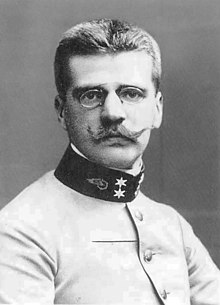| This article needs additional citations for verification. Please help improve this article by adding citations to reliable sources. Unsourced material may be challenged and removed. Find sources: "Gunther Burstyn" – news · newspapers · books · scholar · JSTOR (November 2020) (Learn how and when to remove this message) |


Gunther Adolf Burstyn (6 July 1879 in Bad Aussee, Steiermark – 15 April 1945 in Korneuburg, Lower Austria) was an inventor, technician, and officer of the Austro-Hungarian Army. He is best known for his Motorgeschütz, the first detailed concept of a modern tank.
Personal life
Burstyn's father Adolf Burstyn came from a Jewish family in Lviv, but Burstyn converted to Catholicism along with his spouse Juliane (née Hoffman). Burstyn was initially christened "Günther," but in later life chose to omit the umlaut and use the name "Gunther".
Invention of the tank
In 1911, he produced and patented the first design of a cross-country fighting vehicle with swivelling gun turret (a tank), based on the gun turrets from naval warships and armoured vehicles using the then decade-old combustion engine. He called his tank the Motorgeschütz (literally "motor-gun"). His draft design, more advanced than some of the tank designs of World War I, was rejected both by Austria-Hungary and by the German Empire and no prototype was ever produced. He later sought to patent his design, but was told that it might infringe existing patents, so he dropped all plans to do so.
The vehicle would have been 3.5m long, 1.9m wide and 1.9m tall. It would have been armed with a light rapid firing cannon (30-40mm calibre) and possessed a road speed of 29 km/h and an off-road speed of 8 km/h. The vehicle would have been powered by a 60 hp truck engine. The four auxiliary wheels could be raised and lowered; the rear would be able to assist in traction while the front pair could be pivoted for steering. The vehicle was envisioned as being used to attack enemy machinegun nests and supporting infantry attacks, as well as attacking enemy artillery positions.
World War II
At the beginning of World War II, Burstyn supported the NSDAP.
On March 31, 1941, Burstyn was able to personally present his tank innovations to Adolf Hitler. Burstyn was awarded the War Merit Cross, 1st and 2nd class, with Swords.
At the end of the war (April 1945), he committed suicide because he feared Soviet captivity.
See also
References
- "Burstyn Motorgeschütz".
- Daniela Angetter, Ewald Angetter: Gunther Burstyn (1879–1945). Sein „Panzer“ – eine bahnbrechende Erfindung zur falschen Zeit am falschen Ort. (=Österreichisches biographisches Lexikon. Schriftenreihe Band 11) Verlag der Österreichischen Akademie der Wissenschaften, Wien 2008, ISBN 978-3-7001-6530-9
- Angwetter, D.& E.;Gunther Burstyn. Verlag Der Österreichischen Akademie Der Wissenschaften, 2008.
- See:
- Malnig, Helmut W. (2009) "Der erste Kampfpanzer der Welt: Gunther Burstyn und sein "Motorgeschütz" " , Truppendienst, 309 (3) . Available at: Austrian Federal Army: Truppendienst Archived 2018-06-08 at the Wayback Machine
- Austrian patent no. 53,248 (filed: 1911 March 1 ; issued: 1912 April 25).
- German patent no. 252,815 (issued: 1912 February 28).
- (Anon.) (1922) "Who invented the tank?" Army Ordnance, 4: 36.
- The Burstyn Tank, Landships.com
- The Burstyn Tank, Landships.com
- "Burstyn, Günther". Austria-forum (in German). Retrieved 14 December 2013.
External links
- http://www.doppeladler.com/kuk/burstyn.htm. Biography (in German)
- 1879 births
- 1945 suicides
- 1945 deaths
- People from Bad Aussee
- Austro-Hungarian military personnel of World War I
- Austro-Hungarian Army officers
- Austrian military engineers
- Austrian Nazis
- Austrian people of Jewish descent
- History of the tank
- 20th-century Austrian military personnel
- Nazis who died by suicide in Austria